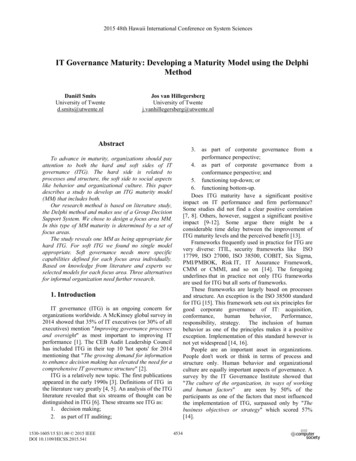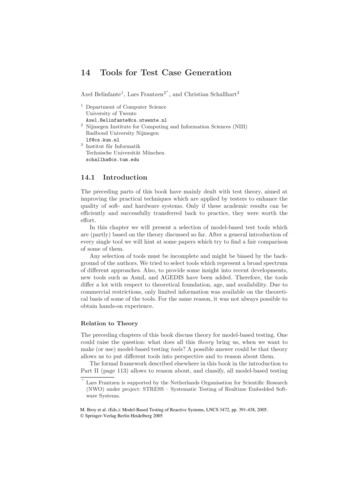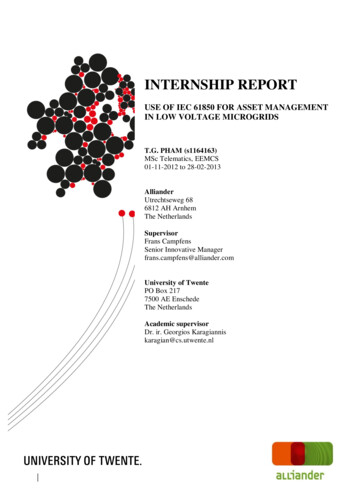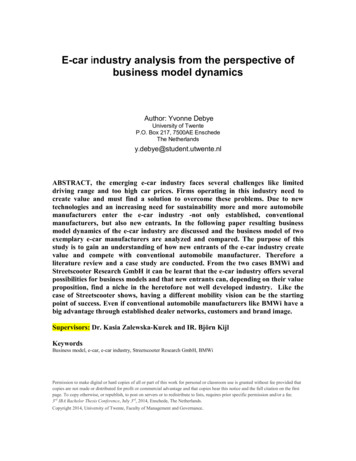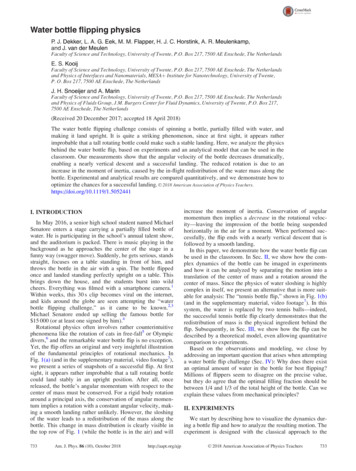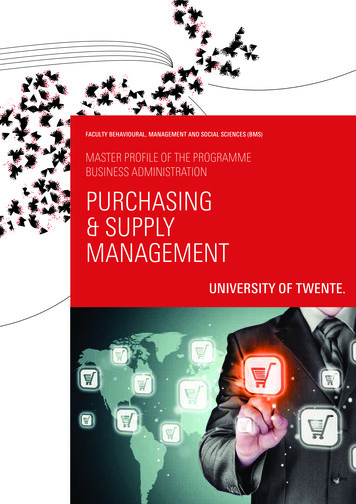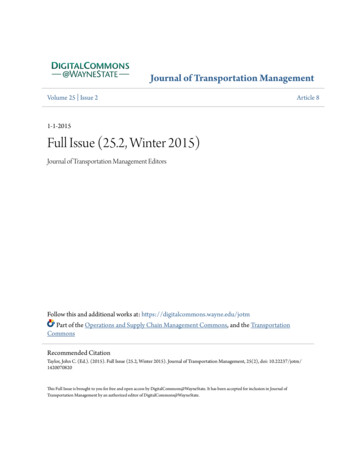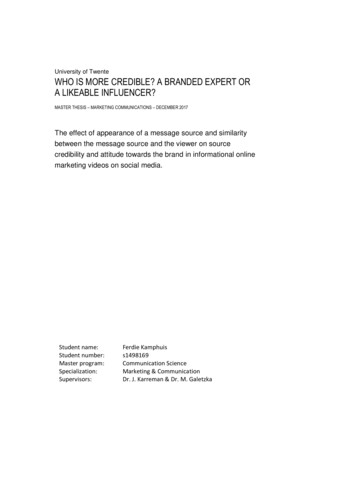
Transcription
University of TwenteWHO IS MORE CREDIBLE? A BRANDED EXPERT ORA LIKEABLE INFLUENCER?MASTER THESIS – MARKETING COMMUNICATIONS – DECEMBER 2017The effect of appearance of a message source and similaritybetween the message source and the viewer on sourcecredibility and attitude towards the brand in informational onlinemarketing videos on social media.Student name:Student number:Master program:Specialization:Supervisors:Ferdie Kamphuiss1498169Communication ScienceMarketing & CommunicationDr. J. Karreman & Dr. M. Galetzka
UNIVERSITY OF TWENTE - MASTER THESISABSTRACTOnline informational videos are a very popular way of advertising on social media for brands.However, social media users feel intruded by ads from brands on social media and seem toprefer content that is authentic and not directly related to promotion of a brand. Therefore, brandstry to create videos that contain value for social media users. Within this research, aninformational video about the Instagram features ‘Stories’, that links to a blog on the website ofan online marketing agency, is used to examine the effectiveness of such videos. Sourcecredibility of the message source plays a role in the persuasiveness of these videos.This research examines the difference in perceived source credibility between a message sourcethat is clearly related to a brand and a more authentic message source, that is not clearly relatedto a brand. The appearance of the message sources in four different informational onlinemarketing videos created for social media are manipulated in terms of clothing and gender, inorder to find out which message source influences source credibility, attitude towards the videoand attitude towards the brand more. Results of the study indicate that that the effect of gender(of the message source and the viewer) and a branded or non-branded appearance of themessage source on source credibility and attitude towards the brand are highly contextdependent. The results also indicate that gender of the message source or gender of the viewerdo not really influence source credibility when a gender-neutral topic such as Instagram Stories isdiscussed. Furthermore, the findings of this study show that source credibility has a positiveeffect on attitude towards the brand of the viewer. The outcomes of this study can helpmarketeers and video designers and developers in deciding what type of message source theyshould use for their online informational marketing videos for social media, in order to improvesource credibility, attitude towards the brand and purchase intention.Keywords: source credibility, gender, clothing, similarity, expertise, likeability, trustworthiness,attitude towards the brand, purchase intention, online informational marketing videos, socialmedia2
UNIVERSITY OF TWENTE - MASTER THESISCONTENTS1.Introduction42.Theoretical framework62.1Informational online marketing videos on social media62.2Appearance of the message source72.3Gender92.4Source 3Trustworthiness112.5Attitude towards the video102.6Attitude towards the brand112.7Level of involvement and product knowledge11Methodology143.1Research design143.2Procedure153.3Stimuli material153.4Pre-test163.5Measurement scales183.5.1Source credibility scales183.5.2Level of involvement and product knowledge scales193.5.3Attitude towards the video scales203.5.4Attitude towards the brand scales203.64.2.2.1Participants21Results224.1Test of normality224.2The effects of independent variables224.3Moderation analysis26Discussion275.1Main findings275.2Limitations and suggestions for future 8I.Survey questions38II.Factor analysis443
UNIVERSITY OF TWENTE - MASTER THESIS1. INTRODUCTIONOnline advertising videos on social media are a very popular marketing tool for brands nowadays(Mc Coy, 2016; De Mers, 2015). However, a lot of marketeers are confronted with the fact thattheir branded content on social media is perceived as intrusive, out of place and not welcome(Fournier & Avery, 2011). In their article The Uninvited Brand, Fournier and Avery (2011)compare social media channels to a party, in which all of your friends are present and having agood time, chatting and interacting with each other. Imagine someone you don’t know comesalong during this party and starts interrupting the conversations you are having with your friends,constantly trying to promote his brand and persuading you to buy stuff. This seems intrusive,right? This is exactly why branded content on social media is not always wanted. Moreover, a lotof branded content on social media is perceived as unauthentic (Fournier & Avery, 2011). Manypeople use social media mainly to communicate with friends. ‘Social media is made for people,not for brands’ (Fournier & Avery, 2011). On the other hand, social media can be a great channelfor building brand community. Strong brand communities can have a positive effect on therelationship between the brand and its customers, which in turn can have positive effects onbrand trust, which has a positive effect on brand loyalty (Laroche, Habibi & Richard, 2013).Although a lot of research on marketing content on social media has been done, more researchinto how brands can develop informational marketing video content for social media that isperceived as authentic, not intrusive and that is appreciated by the users, is encouraged (Hsieh,Hsieh & Tang, 2012). Creating social media content that encourages interaction with consumersand gaining knowledge in how to do so, is seen as an important practice by many brandmarketeers (Tuten & Solomon, 2013; Kim, Spiller & Hatchee, 2015). The current research isfocusing specifically on informational online video advertisements on social media. Moreknowledge enables marketeers to create more authentic and more effective informational onlinevideos.The online informational video ads that this research is specifically examining, arecreated as a content marketing tool by The Online Group, an online marketing agency based inAmsterdam. The purpose of these videos is to attract people to read the blog articles on thewebsite of the agency. Besides that, the videos are created to indirectly improve the attitudetowards the brand. To paint the picture; in the videos examined within this research, an individualis shortly introducing the topic of the blog article the video is referring to (usually an explanationor instruction on trends, developments or tools within the online marketing sector). The messagesource within the informational online marketing videos used as stimuli material within thisresearch is either a male or female individual from around 25 years old.The individual that delivers this message plays an important role within these videos,because s/he is within the center of attention and has the task to explain the topic clearly, as wellas attractive and persuasive. The video has to entertain the viewer and trigger the viewer to readthe blog article the video is referring to. Therefore, the credibility of the message source is veryimportant. Source credibility is the extent to which the message source delivers the message in acredible way, according to the viewer. A source that is perceived as highly credible is generallyseen as more persuasive than a source with low credibility (Pornpitakpan, 2004). The messageof the source and the credibility of the source are intertwined (Homburg, 2017). Therefore thesource that delivers a message within an advertisement can influence the attitude of the receiverand has a great impact on the effectiveness of the advertisement (Chaiken, 1980; Heesacker et.al, 1983). What type of source is most credible and likeable for a given message is broadlyresearched and discussed, but it seems to be context dependent. According to Ohanian (1990),there are three components of source credibility; attractiveness, trustworthiness and expertise.Since brands and brand promoted content are not always appreciated on social media(Fournier & Avery, 2011), user-generated content (UGC) is increasing in popularity. UGC can bedefined as content that is created or co-created by consumers, users of a product or fans of a4
UNIVERSITY OF TWENTE - MASTER THESISbrand (Daugherty, Eastin & Bright, 2008; Homburg, 2017). Sponsored user-generated content iscontent that is created by real users, but (visibly or not) sponsored by the brand that is promotedwithin the content.One type of sponsored-UGC is influencer marketing. ‘Influencer marketing is essentiallyvirtual word of mouth, and consumers are much more likely to positively perceive and react to amessage that comes from a trusted friend or persona over a sponsored post that comes from acompany’ (Woods, 2016). This insight contributes to explanation of the current popularity ofvideo-bloggers (vloggers). Vloggers are seen as influencers, because the viewer can relate tothe vlogger and/or perceives the vlogger as attractive or likeable (Hung, Li & Tse, 2011; Wang,2015). Vloggers are often perceived as more credible and authentic than brands, becauseviewers can often relate to vloggers and often have more similarities with vloggers than withbrands. Influencers, such as vloggers, are often perceived as ‘trusted advisors’ (Brown & Hayes,2008; Loeffler, 2016). People are simply more easily persuaded into attitude change by someonethey like and feel similar to.An attribute of a message source in an online informational video that could influence thejudgement of similarity of the message source with the viewer is gender (Hsieh, Hsieh & Tang,2012). This also ties in with the earlier mentioned finding that people base their judgement onwhether they feel similar to, or like a message source (McGuire, 1985; Reid, Lancuba & Morrow,1997; Desphande & Stayman, 1994; Flanagin & Metzger, 2003). The gender of the messagesource within the video, as well as the gender of the viewer, could influence the overalljudgement of source credibility. Therefore, gender can be seen as an operationalization ofsimilarity.To manipulate the branded or non-branded condition within the experiment, differenttypes of clothing are used. Earlier research has shown that clothing can influence the perceptionof a message source and can have a strong influence on perceived source credibility. Therefore,within this experiment, the message source will either wear a piece of clothing that is clearlybranded. Within the non-branded condition though, the message source will wear a piece ofclothing that is not directly related to the brand that the message source mentions within thevideo.Clothing and gender of the message source are also used to manipulate similaritybetween the message source and the viewer of the online informational marketing video. Sinceearlier research indicates that people are more easily influenced by people they like or feelsimilar to. The theory behind this is more extensively described within the theoretical framework.The current research is trying to gain more insights in the effect of branded content andnon-branded content and gender of the message source and the viewer on source credibility andattitude. Is a message source that is clearly a representative of a brand perceived as morecredible than a message source that is perceived as a ‘non-branded’ user or fan of a brand? Andhow does this influence attitude towards the brand? What type of source is more effective? Bymeans of theoretical research and a field experiment, conducted under 300 students, the effectof gender and branded clothing and non-branded clothing on source credibility and attitudetowards the brand is examined. The main question that this study is trying to answer is:- What is the effect of gender of the viewer and the message source (male vs. female)and a branded vs. non-branded appearance of the message source in an informationalonline marketing video on the perceived credibility of the message source and theattitude towards the video and the attitude towards the brand?5
UNIVERSITY OF TWENTE - MASTER THESIS2.THEORETICAL FRAMEWORKIn this chapter the theoretical substantiation of this research is discussed. First of all, some moreinsights will be given into what is already known about informational online marketing videos onsocial media. This is followed by an extensive explanation of the dependent and independentvariables and the moderators, that are present within this research. Furthermore, the hypothesesformulated for the different constructs within the research are discribed.2.1 Informational online marketing videos on social mediaInformational online videos are often used for advertising purposes. These type of videos canpositively influence purchase intention (Huarng, Yu & Huang, 2010; Homburg, 2017).Informational (advertising) videos focus on ‘providing meaningful facts to the consumer’ (Cutler,Thomas & Rao, 2008), often in order to (besides educating the consumer) gain more brandawareness, a more positive brand attitude or to (indirectly) increase purchase intention of theviewer. Informational advertising is regularly combined with transformational advertising, which isdefined as; ‘advertising that attempts to move the consumer emotionally to a point of greaterproduct acceptance’ (Cutler, Thomas & Rao, 2008).Informational online videos used for advertising purposes can be viewed as a part ofcontent marketing. Content marketing is a marketing strategy suggesting that ‘’brands giveinteresting and valuable information to their customers without asking for anything in return’’(VanWaveren, 2015). Like mentioned in the introduction paragraph, brands are not always wantedwithin the ‘social media party’ (Fournier & Avery, 2011). This is why the focus in online marketingon social media has shifted more and more towards content marketing. Brands want to createcontent that is appreciated by the user on social media and that adds value to the life of thesocial media user. Research has shown that videos can increase learning performance andsatisfaction (Zhang et al., 2006), therefore it could be a great tool to educate the target group andbe seen as valuable content.Content on social media channels is getting more visual and the popularity of videos onsocial media is rapidly growing. Furthermore, with the arrival of features such as ‘stories’ andsocial media channels such as Snapchat and Instagram, which enable users to share theireveryday happenings through photos and short videos, a lot of content that social media usersproduce and view nowadays is video content (Walters, 2015). Therefore, it seems that video is atype of content that is very much appreciated by social media users. Thus, online marketeers arevery interested in videos as an online marketing instrument (Hsieh, Hsieh & Tang, 2012). Theaim of this research is to gain more insights into what type of message source (branded/nonbranded and male/female) is perceived as most suitable to deliver a message within aninformational online advertising on social media.2.2 Appearance of the message sourceWithin this study, appearance of the message source is manipulated by gender and clothing.Studies have shown that apparel can influence source credibility. A change in clothing cansignificantly impact inferences about the personality of the message source (Bell, 1991; Paek,1986; Howlett et al., 2013). According to Damhorst (1990) ‘dress is a systematic means oftransmission of information about the wearer’ (Howlett et al., 2013). Clothing is a powerfulcommunication tool, because the impression a person transmits is highly dependable on theclothes the person wears (Howlett et al., 2013). Therefore, clothing has a huge influence on firstimpression. To date, not much research has focused on the role of branded clothing withininformational online video advertisements. However, from previous studies we can derive someeffects of clothing on source credibility.6
UNIVERSITY OF TWENTE - MASTER THESISO’Neal and Lapitsky (1991) found that when the source was appropriately dressed forthe task addressed within an advertisement, the credibility of the source and the purchaseintention were rated significantly higher than for any other dress-by-situation manipulation.Many studies have assessed the relationship between clothing and authority and expertise(Johnson et al., 2008). Researchers have found that clothing of a message source can have apositive effect on perceived authority of the message source and that clothing can affectbehavioral responses (Bushman, 1984; Bickman, 1974; Geffner & Gross, 1984). When a sourcein an advertisement wears clothing that suits the message of the advertisement, the source isperceived as more credible and the viewers are more likely to buy the product the advertisementpromotes (O'Neal & Lapitsky, 1991; Howlett et al., 2013). Studies have shown that a doctor’scoat (Brase & Richmond, 2004), a police uniform (Richard & Johnson, 2001) or a firefighteruniform (Bushman 1988) have a positive effect on perceived authority, in comparison to casualclothing. Bushman (1988), also found that ‘a uniform is a certificate of legitimacy for females aswell as males’. This suggests that both sexes can be influenced by both sexes in uniform.Furthermore, Brase & Richmond (2004) found that ‘casual clothing decreases perceptions ofauthority, regardless of the gender’.In a study by Reid et al. (1997), students with similar clothing as the experiments’participants (which were also students) were rated more positive than students with a differentclothing style. Bell (1991) found that a formally dressed man received more positive judgementsthan a casually dressed man (Howlett et al., 2013).This experiment will explore the effect of different appearances of message sourceswithin online marketing videos on source credibility and attitude (towards the video and towardsthe brand). More specifically the effect of branded clothing and clothing that is not clearly relatedto the brand the video is referring to (non-branded clothing). Source credibility consists out ofthree components: expertise, likeability and trustworthiness. The effect of appearance will betested on all these three components. Earlier research has shown that clothing can have apositive effect on source credibility and that this can positively affect brand attitude. However, thishas not yet been researched in the same context as this current study. In this current research,the expectation is that branded clothing will positively influence the expertise component of themessage source. Because branded clothing is expected to be perceived as a cue of authority orexpertise of the message source by the viewer. At the same time, non-branded (casual) clothingis expected to influence the feeling of similiarity of the viewer with the source, and mighttherefore positively influence likeability. This expectation is elaborated more extensively withinparagraph 2.3. The effect of branded vs. non-branded (casual) clothing on trustworthiness of themessage source will also be tested. Branded clothing could enhance perceived expertise,however an informational video coming from a commercial organization might also be perceivedas less trustworthy, because it could be perceived as blunt advertising. Therefore, casualclothing could also increase perceived trustworthiness, because a source that is perceived asindependent and not from an organization, could be perceived as more trustworthy. Based onthese notations, the following hypotheses can be formulated:H1: A message source who wears branded clothing within an informational online marketingvideo is perceived to be more credible than a message source who wears non-branded clothing.H1a: A message source who wears branded clothing within an informational online marketingvideo is perceived to have more expertise than a message source who wears non-brandedclothing.H1b: A message source who wears non-branded clothing within an informational onlinemarketing video is perceived to be more likeable than a message source who wears brandedclothing.H1c: A message source who wears branded clothing within an informational online marketingvideo is perceived as less trustworthy than a message source who wears non-branded clothing.Based on the earlier studies described within this paragraph, it can be concluded that there are alot of contradicting findings regarding the effect of clothing on source credibility and the three7
UNIVERSITY OF TWENTE - MASTER THESISdifferent components of source credibility. The hypotheses that have been formulated for thiscurrent study, are based on expectations of the effects of clothing on source credibility andattitude towards the brand within the context of this research.H2b: A message source who wears branded clothing within an informational online marketingvideo has a positive effect on attitude towards the video.H2c: A message source who wears branded clothing within an informational online marketingvideo has a positive effect on attitude towards the brand.2.3 GenderAnother factor that could influence source credibility is gender (Armstrong & McAdams, 2009),which has been a key variable for marketing analysis for a long time (Wolin & Korgaonkar, 2003).Whether the receiver of a message is persuaded into attitude change by the source of amessage, is in several cases dependable on gender. According to Flanagin and Metzger (2003),gender can been seen as physical characteristics of a source, that influence persuasivenessdirectly, as well as a marker of similiairity or dissimiliairity with the viewer. Both can influenceperception of a source’s credibility. This means both the gender of the source and the gender ofthe receiver play a role here. According to Gass and Seiter (1989) and Carli (2001), men are ingeneral perceived as more persuasive than women. At the same time, women are moreinfluencable than men (Aronson, 1972; Eagly, 1978).The effect of gender on source credibility and attitude change is broadly discussed withinearlier studies, but results are conflicting. Since (like mentioned before) some researchersindicate that people are more likely to trust individuals that are similar to them (Deshpandé &Stayman, 1994), one might assume that people are more easily influenced by a source of thesame sex. This is confirmed by Caballero et al. (1989), who found that males showed greaterintentions to buy from male endorsers and females hold greater intentions to purchase fromfemale endorsers. Other researchers also found that people are more easily persuaded by asource of the same sex (Bochner, 1994; White & Andsager, 1991). However, Gass and Seiter(2004), state the opposite in their book ‘Persuasion, social influence and compliance gaining’.They claim that people are more likely to be influenced by the opposite sex. However, they alsostate that this effect is stronger for males persuading females, than for females persuadingmales. Related to this, Carli (2001) found that males in particular resist influence by women morethan females do. Carli also states that research on descriptive gender stereotypes indicates thatwomen are perceived as less expert and, in general, are perceived to have less knowledge thanmen. An exception for this, is situations in which female expertise is favored (for example,products that are specifically for women) (Carli, 1999; Wood & Karten, 1986; Feldman-Summers,et al., 1980). Other studies also explored the difference between men and women in perceivedexpertise, in different contexts. In most contexts men were perceived as more expert thanwomen (Brownlow & Zebrowitz, 1990; Carocci, 1988; Armstrong & McAdams, 2009; Flanagin &Metzger, 2009). For example, Armstrong and McAdams (2009) discovered that when readingblogs that were claimed to be written by an expert, but in which the gender of the writer wasunknown, most respondents automatically assumed that the writer was a male. They also foundthat blogs that were written by men were perceived as more credible than blogs written bywomen. Furthermore, in a study by Rudman and Kilianski (2000), in which implicit attitudestowards authority were measured, men were linked to high-authority roles while women werelinked to low-authority roles. The study by Rudman and Kilianski (2000), along with the claims ofother scholars on this topic, suggest that men are generally perceived as more persuasive,expert and authoritarian than women.As claimed by Ohanian (1990), attractiveness is also an important component of sourcecredibility. Debevec and Kernan (1984) found that attractive female models generated moreenhanced attitudes than attractive male models accross both genders, but particularly amongmales.Why is gender important in the context of this research? In general the effect of genderon source credbility and attitude change seems to be highly dependable on the context and on8
UNIVERSITY OF TWENTE - MASTER THESISthe gender of both the source of the message and the receiver of the message (Carli, 2001;Wolin, 2003; Harmon & Coney, 1982). Although most studies show that women are lessinfluential than men, one cannot simply state that this will also be the case for other contexts(Carli, 2001). The findings of different scholars on the effect of gender on source credibility andattitude change are highly contradicting and controversy exists (Wolin, 2003). Therefore it isassumed that the effect of gender of the source on source credibility is highly context dependent.Within this research, the message source (either male or female) discussess a gender neutralsubject (Instagram Stories). Not much research has been done about the effect of gender onsource credibilty regarding such a gender neutral topic. It is interesting to examine if the effectsof different genders of message sources and message receivers are also applicable for such agender neutral topic. Maybe this research will discover a completely different effect of gender onsource credibility than earlier research did, because of the different context of this research.Although we cannot yet say much about the effect of gender of both the source and theviewer in this context, some assumptions can be made based on earlier research. It is expectedthat within online informational video advertisements for an online marketing agency, men areperceived as more expert by both male and female viewers. Furthermore, the expectation is thatthe overall credibility of the source will be higher when the viewer is the same sex as themessage source, compared to when the video is watched by the opposite sex. This expectationis based on earlier studies, claiming that likeability and trustworthiness are influenced bysimiliairity and attractiveness. The following hypotheses about the effect of gender on sourcecredibility can be formulated:H3a: An online informational marketing video with a male message source will have a positiveeffect on expertise, when watched by both a male viewer or a female viewer.H3b: An online informational marketing video with a male message source will have a morepositive effect on likeability when watched by a female viewer than when watched by a maleviewer.H3c: An online informational marketing video with a male message source will have a morepositive effect on trustworthiness when watched by a male viewer than when watched by afemale viewer.H4a: An online informational marketing video with a female message source will have a morepositive effect on likeability when watched by male viewers than by female viewers.H4b: An online informational marketing video with a female message source will have a morepositive effect on trustworthiness when watched by female viewers than when watched by maleviewers.2.4 Source credibilityOne of the variables that could influence the effectiveness of informational online marketingvideos on social media that is examined within this study is source credibility. Like mentionedbefore, according to Ohanian (1990), there are three components of source credibility;attractiveness, trustworthiness and expertise. Several studies show that a source that isperceived as more expert (Anderson & Clevenger, 1961; Wilson & Sherrell, 1993), moretrustworthy (Andreoli & Worchel, 1978) and/or more attractive, is more persuasive (Smink, 2013;McGuire, 1968; Sternthal, et al., 1978; Wilson & Sherrell, 1993). This corresponds with thecomponents of attractiveness and expertise as determinants of source credibility. HoweverErdogan (1999), among other researchers, states that attractiveness is a component oflikeability, along with similarity (McGuire, 1985; Cohen & Golden, 1972; O’Keefe, 1990).Attractiveness and similiarity even seem to strengthen each other, as several studies haveshown that increased similarity leads to increased attraction (Byrne & Nelson, 1965; Silverman,1974; Flanagin & Metzger, 2003). Therefore, within this research, the source credibilitycomponent that Ohanian called attractiveness will be replaced by likeability, which consists out ofattractiveness and similiarity.9
UNIVERSITY OF TWENTE - MASTER THESIS2.2.1 ExpertiseOhanian (1990) defines expertise as ‘the knowledge that the communicator seems to possess tosupport the claims made in advertisements’. Silvera and Austad (2004) confirm this with theirdefinition of expertise of an endorser. They state that ‘expertise refers to the (product) knowledgeof the endorser and thus to the validity of his/her claims regarding the product’. When thereceiver of a message perceives that the source of a message possesses a given level ofexpertise, the validity of the message of the source is expected to be higher (Hovland et al.,1953). Perceived expertise of a source can also lead to attitude change. Wiener and Mowen(1986), among others, found that ‘expert sources induce more immediate attitude change thando sources having less expertise’. It does not matter whether the message source actually is anexpert, as long as the receiver of
of branded content on social media is perceived as unauthentic (Fournier & Avery, 2011). Many people use social media mainly to communicate with friends. ‘Social media is made for people, not for brands’ (Fournier & Avery, 2011). On the other hand, social media
